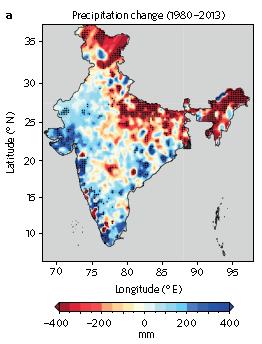Changing rainfall patterns linked to water security in India

Changing precipitation in India, 1980-2013 Asoka et al 2017
Changing rainfall is the key factor driving changes in groundwater storage in India, according to a new study led by the Indian Institute of Technology (IIT) Gandhinagar published in the journal Nature Geoscience. The study shows that changing monsoon patterns—which are tied to higher temperatures in the Indian Ocean—are an even greater driver of change in groundwater storage than the pumping of groundwater for agriculture.
Agriculture in India relies heavily on groundwater for irrigation, particularly in the dry northern regions where precipitation is scarce. Groundwater withdrawals in the country have increased over tenfold since the 1950’s, from 10-20 cubic kilometers per year in 1950, to 240-260 cubic kilometers per year in 2009. And satellite measurements have shown major declines in groundwater storage in some parts of the country, particularly in northern India.
“Groundwater plays a vital role in food and water security in India. Sustainable use of groundwater resources for irrigation is the key for future food grain production,” says study leader Vimal Mishra, of the IIT Gandhinagar. “And with a fast-growing population, managing groundwater sustainably is going become even more important. The linkage between monsoon rainfall and groundwater can suggest ways to enhance groundwater recharge in India and especially in the regions where rainfall has been declining, such as the Indo-Gangetic Plain.”
Groundwater acts like a bank for water storage, receiving deposits from surface water and precipitation, and withdrawals as people pump out water for drinking, industry, and irrigating fields. If withdrawals add up to more than the deposits, eventually the accounts could run dry, which could have disastrous consequences.
“This study adds another dimension to the existing water management framework. We need to consider not just the withdrawals, but also the deposits in the system,” says Yoshihide Wada, a study coauthor and the deputy director of the Water program at the International Institute for Applied Systems Analysis (IIASA) in Austria.
The issue of groundwater depletion has been a topic of much discussion in India, but most planning has focused on pumping, or the demand side, rather than the deposit side. By looking at water levels in wells around the country, the researchers could track groundwater replenishment following the monsoons. They found that in fact, variability in the monsoons is the key factor driving the changing groundwater storage levels across the country, even as withdrawals increase.
In addition, the researchers found that the monsoon precipitation is correlated with Indian Ocean temperature, a finding which could potentially help to improve precipitation forecasts and aid in water resource planning.
“Weather is uncertain by nature, and the impacts of climate change are extremely difficult to predict at a regional level,” says Wada “But our research suggests that we must focus more attention on this side of the equation if we want to sustainably manage water resources for the future.”
Reference
Asoka A, Gleeson T, Wada Y, Mishra V, (2017). Relative contribution of monsoon precipitation and pumping to changes in groundwater storage in India. Nature Geoscience.9 January 2017. doi:10.1038/ngeo2869.
http://www.iiasa.ac.at/web/home/about/news/170109-groundwater.html
Media Contact
All latest news from the category: Earth Sciences
Earth Sciences (also referred to as Geosciences), which deals with basic issues surrounding our planet, plays a vital role in the area of energy and raw materials supply.
Earth Sciences comprises subjects such as geology, geography, geological informatics, paleontology, mineralogy, petrography, crystallography, geophysics, geodesy, glaciology, cartography, photogrammetry, meteorology and seismology, early-warning systems, earthquake research and polar research.
Newest articles

Recovering phosphorus from sewage sludge ash
Chemical and heat treatment of sewage sludge can recover phosphorus in a process that could help address the problem of diminishing supplies of phosphorus ores. Valuable supplies of phosphorus could…

Efficient, sustainable and cost-effective hybrid energy storage system for modern power grids
EU project HyFlow: Over three years of research, the consortium of the EU project HyFlow has successfully developed a highly efficient, sustainable, and cost-effective hybrid energy storage system (HESS) that…

After 25 years, researchers uncover genetic cause of rare neurological disease
Some families call it a trial of faith. Others just call it a curse. The progressive neurological disease known as spinocerebellar ataxia 4 (SCA4) is a rare condition, but its…





















